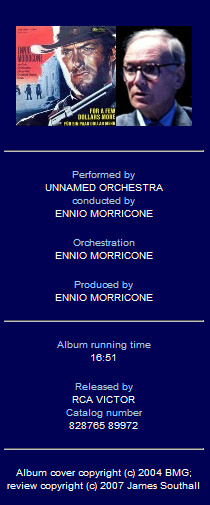|
黄昏双镖客
|
|
天才的莫里康内和莱昂内,有目共睹的令人称道的电影和音乐
|
|
詹姆斯
绍索尔 中译文 马涌
|
|
|
|
塞尔吉奥·莱昂内"赏金三部曲"中间的那一部电影是经常被人们遗忘的,不过与另外两部一样,它是一部惊人的电影,毫无疑问它充满了爆炸性的影像时刻和莱昂内的招牌风格。类型大于实质?绝无可能-虽然西部片类型多如牛毛,不过也是基于事实依据。克林特·伊斯特伍德又回来了,无疑-这是李·范·克里夫首度与他合作-滑稽的配音,意大利龙套演员倾巢出动-每一个标志性的银幕瞬间都伴随着一个银幕之外的标志性事物,那就是埃尼奥·莫里康内提供的音乐。
|
|
|
|
在我的脑海里,莫里康内为莱昂内谱写的音乐是最异乎寻常的极具创意的和辉煌的电影音乐。值得注意的是它是如此棒的作品-这部电影兼顾了太多的戏剧性而且可以让音乐发烧友充分享受这张专辑。享受它们,值得拥有-低预算电影的音乐,这部意大利制造的西部片理应是其中最著名的,这部电影见证了非凡的才华,这位作曲家必须捕捉情绪并提出那个时代的原声音乐。(别急,一会儿还有另外一些陈词滥调即将到来。)
"对决"开启了这张专辑-标志性的木琴,电吉他,架子鼓-如此激动人心-之后是合唱-以及巨大的教堂管风琴-最后是小号独奏-这支曲子结束后,我觉得自己像做爱之后一样酣畅淋漓。不同的元素完美地结合聚集在一起,就好像它完全自然而然地以这种方式出现-还没有任何人能与莫里康内相提并论,它的确是最难以置信的音乐。
接下来是一支悬念曲子,一个诗意的标题"观察观察"(惟有莫里康内…)-刺耳的弦乐,不安的萨克斯(也许是单簧管);然后是轻快的"杀人的习惯",在双簧管和合唱接管之前,电吉他被用来提供华丽的旋律。其后音乐一路飙升-简直惬意之极。之后…加入了艾达·戴洛尔索的声音1-时间不是太长-不过它肯定是足够长的另一个标志性时刻。"射击"随之而来…以一个不同的配乐,一个不同的瞬间,它似乎是没完没了的悬念-但不知何故,莫里康内使得这种普通的打击乐节奏如此地时尚,他以如此令人惊叹的音乐环绕整支曲子,即便它是一个小小的杰作。
"再见上校"是最向往和最美妙的主题-正如你所听到的,你几乎可以看到他俩共同援手迈向希望(告诉你另外一些陈词滥调,远方就在脚下)。简直激动人心,令人叹服。所有这一切的主菜还没有到来。标题所暗示的"黄昏双镖客"那支曲子,是一个艺术品-一个男人吹着口哨,一个哔哔蹦蹦的声音,一个飘扬的低音长笛,突然出现的男声合唱咕噜声,电吉他声...
惟有莫里康内… 它几乎与比它还著名的《黄金三镖客》一样出色,这支曲子我可以设定在"重复"播放,连续听上一整天。
如果没有一支滑稽的低级酒吧钢琴源音乐,任何莫里康内的西部原声音乐都是不完整的,"扑克王牌"正是这样一支曲子;你不可能一本正经地去听它,不过你真的会喜欢上这支曲子。"怀表"结束了这张专辑-它是开场旋律的一个重奏,这次它有着一个更加美妙的声音。《黄昏双镖客》是一个天才之作,一部勿庸置疑的五星级大作,简单、醇厚、经典的莫里康内作品。与所有莫里康内创作过的其他莱昂内原声音乐一样,它大约发行了六千五百万份不同版本的唱片,其中最常见的是这张8音轨的CD,它持续、惊人地再现了这个电影音乐的原版专辑,仅有17分钟的时长(即便是扩展版本推出的时候,我不知何故竟然没有注意到这一点)。它们是如此经典的17分钟。
|
|
|
|
专辑曲目 专辑曲目及信息(CD
BMG 82876589972 - 2004)2
|
1/1 3:02 La resa dei conti 对决 
1/2 2:00 Osservatori osservati 观察观察

1/3 2:23 Il vizio d'uccidere 杀人的习惯

1/4 2:20 Il colpo 射击 
1/5 1:45 Addio colonnello 再见上校 
1/6 2:46 Per qualche dollaro in più
黄昏双镖客 
1/7 1:20 Poker d'assi 扑克王牌 
1/8 1:10 Carillon 怀表 
|
|
作曲,管弦乐编曲:埃尼奥·莫里康内
指挥:埃尼奥·莫里康内,布鲁诺·尼可莱(Bruno Nicolai)
合唱:亚历山德罗尼现代合唱团(I Cantori Moderni di Alessandroni)
女声:艾达·戴洛尔索(Edda Dell'Orso)
口哨,吉他:亚历山德罗·亚历山德罗尼(Alessandro Alessandroni)
吉他:布鲁诺·巴提斯蒂·达玛修(Bruno Battisti D'Amario)
小号:尼科拉·库拉索(Nicola Culasso)
风琴:布鲁诺·尼可莱(Bruno Nicolai)
|
1 《黄昏双镖客》是艾达·戴洛尔索与莫里康内的首度合作。
2 http://www.chimai.com/index.cfm?module=MUS&mode=ALB&id=2486,https://en.wikipedia.org/wiki/For_a_Few_Dollars_More。
|
|
****************************************************
|
|
|
|
|
|
***********************************************************************
|
|
|
|

|
The middle part
of Sergio Leone's "Dollars Trilogy"
is the one that's most often forgotten, but like
the two either side it is a startling film, absolutely
full of dynamite cinematic moments, directed with
Leone's trademark flair. Style over substance?
No way - oceans of style, but substance too. Clint
Eastwood's back, of course - Lee Van Cleef joins
him for the first time - the hilariously-dubbed
Italian bit-part players are out in full force
- and every iconic on-screen moment is accompanied
by an iconic off-screen one, courtesy of Ennio
Morricone's music.
In my mind, Morricone's music
for Leone represents the most outlandishly creative
and brilliant film music ever written. The remarkable
thing is how well it works - both with the operatic
excesses of the films, and on albums for music
fans to enjoy. And enjoy them, they have - that
the music from low-budget, Italian-produced
westerns should be amongst the most famous written
for films is testimony to the remarkable ability
this composer had to capture a mood and provide
the soundtrack to a generation. (Don't worry,
there'll be another cliche coming in a few moments.)
"La Resa Dei Conti"
opens things up - the iconic xylophone, electric
guitar, drums - so atmospheric - then the choir
- the humungous church organ - finally, that
trumpet solo - when it's over, I feel like having
a post-coital cigarette. Such a perfect combination
of disparate elements, coming together as if
it's entirely natural for music to be made this
way - but nobody other than Morricone ever has,
which is what is truly the most incredible thing.
Suspense is up next, in the
poetically-titled "Osservatori Osservati"
(only Morricone...) - screeching strings, stings
from sax (or maybe it's a clarinet); then the
lilting "Il Vizio d'Uccidere", the
electric guitar now being used to provide gorgeous
melody before oboe and choir take it over. Then,
it soars - simply heavenly. Then... enter Edda
dell'Orso - not for long - but certainly long
enough for another of those iconic moments.
"Il Colpo" follows... in a different
score, in a different time, this would seem
like interminable suspense - but somehow Morricone
makes the simple percussion rhythms so damn
stylish, and surrounds it with music of such
wonder, even this seems like a little masterpiece.
|
|
|
"Addio Colonnello" is the
most yearning and beautiful of the themes - you can almost
see the hand reaching out towards hope (told you another
cliche wouldn't be far around the corner) as you listen.
Stirring, stunning. All this, and the pièce de résistance
hasn't even arrived yet. The title cue "Per Qualche
Dollario in Piu" is that pièce, that objet d'art
- a man whistling, a bouncing boinging noise, a fluttering
bass flute, a male choir popping up to grunt gutturally
for a few bars, the electric guitar... only Morricone...
It's every bit as good as its more celebrated counterpart
in The Good, the Bad and the Ugly, the sort of piece I
could place on "repeat" and listen to for 24
hours straight.
No Morricone western score would be
complete without a ridiculous piece of honky-tonk piano
source music, and "Poker d'Assi" is that piece
here; you can't keep a straight face, but you can't fail
to love it, either. "Carillon" closes things
out - a reprise of the opening melody, this time with
an even grander sound. For a Few Dollars More is a work
of genius, an undoubted five-star masterpiece, simply
vintage, classic Morricone. As with all his other Leone
scores, it has been released in about sixty-five million
different versions on CD, with the most common being this
eight-track CD which mirrors the original album and lasts,
startlingly, for only 17 minutes (even I somehow failed
to notice when the expanded versions came - and went).
But what 17 mintues they are.
|
|
|
|
|
|
|
| |
| |
|
|
|
|
|
|